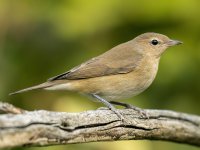Richard Dale
Well-known member
Hi Butty, what I mean by rounded tail shape isn't as literal as you are taking it. I don't mean the tail appears rounded in the images. I mean we can infer from what we see in the first photo that the tail must be rounded in shape: in the first photo we can see that the two outer tail feathers are clearly shorter than the rest of the tail. The foreshortening of the image makes it harder to draw conclusions beyond that, but when the outer tail feathers are shorter than than the inner feathers, that means the bird has a rounded tail shape (when spread) and this is character of Acrocephalus warblers.Nope - it's impossible to do more than guess at the tail-tip-shape, though certainly it's not obviously rounded. But obviously I'd never tell someone that what they think they can see isn't actually there...
A garden warbler has outer tail feathers the same length as the rest of the tail. On the closed tail viewed from below the outer feathers completely cover the rest of the retrices, and the tail shape is square, for want of a better word.
Simon raises the possibility of it regrowing tail feathers, but neither reed/marsh or garden generally moult the tail in autumn, either as adults or juveniles, apparently with the very rare exception of the occasional adult garden warbler (not something I've ever seen in many hundred of birds in the hand). To be regrowing both its outer tail feathers it would have to have lost just these feathers somehow (if it had lost the entire tail all the feathers would be the same length while regrowing).
Having said all that, hopefully, whether or not you concede my point regarding my interpretation of the tail from the first photo, you do now accept that it is clearly an Acrocephalus based on the videos and stills now posted (and therefore it does have a rounded tail). The most anomalous feature, the blue/grey legs, are at the extreme end of variation, and better for 1cy fuscus RW than MW (the lack of any feather wear means it has to be a 1cy bird, and in RW/MW, young birds tend to have darker, greyer legs than adults, and RW tend to have darker legs than MW).




